As is often the case in the Rione Trastevere, time almost seems to stand still in this picturesque alleys. Its current name (Athlete’s Alley) comes from the surprising discovery in 1849 of an almost completely intact statue: the “Apoxyomenos” (from a Greek verb meaning to clean oneself), a young athlete who is depicted whilst cleansing his arm with a kind of curved spoon, the strigil. With a little sand and this tool, which could have been made of bronze, silver, or ivory, ancient athletes used to scrape off the oils used to anoint the body before wrestling competitions, removing also dust and sweat with a “body scrub” effect. Made around the mid first century AD and originally placed at the entrance to the Baths of Agrippa, behind the Pantheon, the statue, today at the Vatican Museums, is a marble copy of one of the bronze masterpieces by the Greek sculptor Lysippus. The story goes that Emperor Tiberius had brought it to his personal residence but the insistence of the people, who insistently demanded it, forced him to return it. Along with the Apoxyomenos, other artifacts were also found in the alley, including parts of statues and a bronze horse, also works by Lysippus and now in the Capitoline Museums. The discovery caused quite a stir, and a few years later, after the Unification of Italy, it was decided to commemorate the event by naming the alley after the athlete who resurfaced intact from underground.
A long history in a few steps
Until that time, this narrow, winding alleyway was still called Vicolo delle Palme (Alley of the Palm Trees) and this “ancient” name tells a page in the history of Rome’s Jewish community, present in the city as early as the second century BC. Trastevere, and precisely the area between the Isola Tiberina, the Basilica of Santa Cecilia and the Church of San Francesco a Ripa, was the focal point of the community around the year 1000. This Giudecca – as the neighborhoods inhabited by Jews were referred to in the Middle Ages – is also witnessed in the street names of the time, which included, for example, the street “de corte Judei” and the “pons Judaeorum”, i.e. Pons Fabricius. Seven synagogues were built in the Rione: the beautiful medieval house along the alleyway, with a graceful arched loggia surmounted by a cornice, is all that remains of one of them. On a column of this little brick jewel are still visible some Hebrew characters that should be read as “Nathan Chay”, a reference to the lexicographer Nathan ben Yehiel, a member of one of Rome’s most prominent Jewish families, who had founded the synagogue in the late 11th century. Inside the building are still the remains of the ancient Mikweh, the basin for ritual bathing, and at an even lower level runs a vein of water, accessible via a well. As for the palm trees that gave the alley its name, they were brought here by the community: depicted on the door of Solomon’s Temple, they are one of the plants of Jewish tradition and symbolize loyalty to God.
Jewish Trastevere
Two centuries later, the synagogue was destroyed by a serious fire. In the meantime, however, the community had gradually shifted to the left bank of the Tiber, to the Rione Sant’Angelo where, in 1555, Pope Paul IV established the ghetto, a run-down district where Jews were forced to live apart from the rest of the population. More recently, the Jewish community has somehow recovered its ancient Roman roots by reappropriating some spaces. Just beyond the old synagogue in Vicolo dell'Atleta, in the direction of the Tiber, a tower building on Via dell’Arco de’ Tolomei, for example, houses the Pitigliani Centro Ebraico Italiano, committed to spreading knowledge of Jewish culture and traditions. Along Lungotevere Sanzio, we can find the Jewish kindergartens, elementary and middle schools, the seat of the Italian Rabbinical College and the Degree Course in Jewish Studies. A little further on, there’s the Unione delle Comunità Ebraiche Italiane and, under the porticoes, just past Piazza Trilussa, the “Tullia Zevi” Bibliographic Center, with a rich heritage of rare books, manuscripts and parchments, and a splendid fresco by Emanuele Luzzati depicting the signs of the Zodiac.
Rione XIII - Trastevere
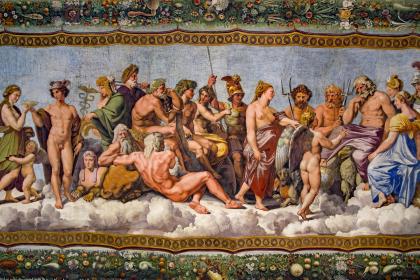
Große Synagoge von Rom (Tempio Maggiore)
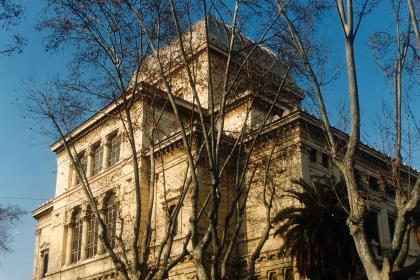
 Condividi
Condividi
Der Tiber
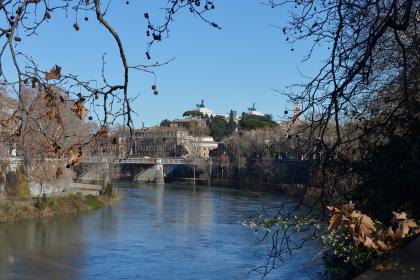
Secondo la leggenda, la storia di Roma comincia proprio da qui
Casina dei Vallati - Museo della Shoah
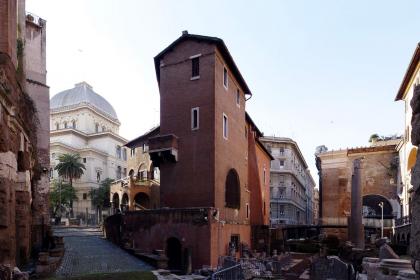
 Condividi
Condividi
Tiberinsel
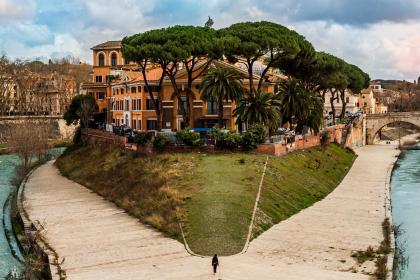
 Condividi
Condividi











































